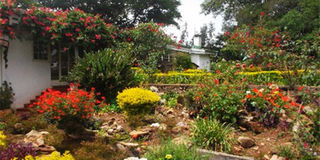Kapsimotwa Gardens

Kapsimotwa House and garden.
What you need to know:
- It is a picturesque countryside which has had its fair share of drama — the most memorable being the infamous murder of the Nandi chief, Koitalel arap Samoei, by Captain Richard Meinerherzgen in 1905.
- The potholed road through town leads us to the nicely graded roads in the tea estates and the maze of tea plantations.
- At Kapsimotwa Gardens, there is a burst of colour — flowers in the most vibrant shades of reds, pinks, purples, yellows, and whites bordered by the tea bushes.
Stretches of tea fields bask in the beautiful sunshine high up in the hills.
It is a picturesque countryside which has had its fair share of drama — the most memorable being the infamous murder of the Nandi chief, Koitalel arap Samoei, by Captain Richard Meinerherzgen in 1905.
The Nandi chief was concerned about new forces barging through the land with an iron snake (railway) and led an 11-year resistance against the British.
In Nandi Hills town I make it a point to stop for a cup of tea at Nandi Bears Club on the way back from the picnic at Kapsimotwa Gardens.
The club, in my view, has the most picturesque golf course in the country.
The potholed road through town leads us to the nicely graded roads in the tea estates and the maze of tea plantations. At Kapsimotwa Gardens, there is a burst of colour — flowers in the most vibrant shades of reds, pinks, purples, yellows, and whites bordered by the tea bushes.
STUNNING VIEWS
The garden surrounds Kapsimwota house, which has spacious rooms and huge windows that open to stunning views of the hills. It was built in the early 1950s by a white farmer.
A few metres away, strolling down to the designated picnic site by the pools, we see dams with ducks and geese swimming in them and a bloom of bright seasonal flowers surrounding the dam.
David Bor, the manager, talks about the tea that is now being planted. It is a new type called purple tea. Traditionally in Kenya, black tea has been planted since 1903.
Kenya takes pride as the largest producer of tea in Africa and as one of the world’s leading black tea producers. Tea is, without a doubt, Kenya’s most important cash crop.
There is a rumble in the distance and looking up, the sky is blue — it must be something else.
Families lay out their picnics at the tables and children scramble out of the cars when the rumble covers the sky with rain clouds and heavy, fat raindrops fall into the dams. The children are bundled back in to wait for the rain to stop.
The rain comes and goes and in the midst of all this the picnic is moved to the verandah of the house since it is available.
A PATCH?
I notice a brown patch. “That’s where we have planted the purple tea,” says Bor.
I ask him what purple tea is. “It’s a new variety of a herbal tea introduced to Kenyan farmers two years ago by the Tea Research Foundation.”
It is expected to raise the fortunes of the farmers. Further reading reveals that the tea’s green leaf is estimated to fetch Sh100 a kilo compared to normal green tea that fetches between Sh12 and Sh20 a kilo.
It has a high medicinal value and demand for it is high in Europe, Asia, and the Far East. Reading more on the fortunes of purple tea, I discover that an acre of tea bushes can earn farmers as much as Sh10 million a year.
On the other hand, Kenya’s black tea, despite being of high quality, is auctioned in bulk and used as a base to mix with other teas.
HEADY LIKE CHAMPAGNE
“The tea bushes take three years to mature and the leaves are then picked every seven days — a technique mastered by tea pickers working at top speed, picking two leaves and a bud.
The crystal-clean air is heady like champagne. The clouds clear and the sky is back to blue. Beyond the peak of the garden, the sugar belt of Chemelil lines the foothills of Nandi.
A herd of cows munch on the lush green grass by the garden belonging to a local resident. It is the veritable land of milk, tea, and sugar.
On our way back, a wrong turn through the maze of tea takes us down a winding road and within minutes we are back on the main tarmac road near Chemelil.
With more people and farms coming up, there are increasingly new roads carved out of the mountains.




